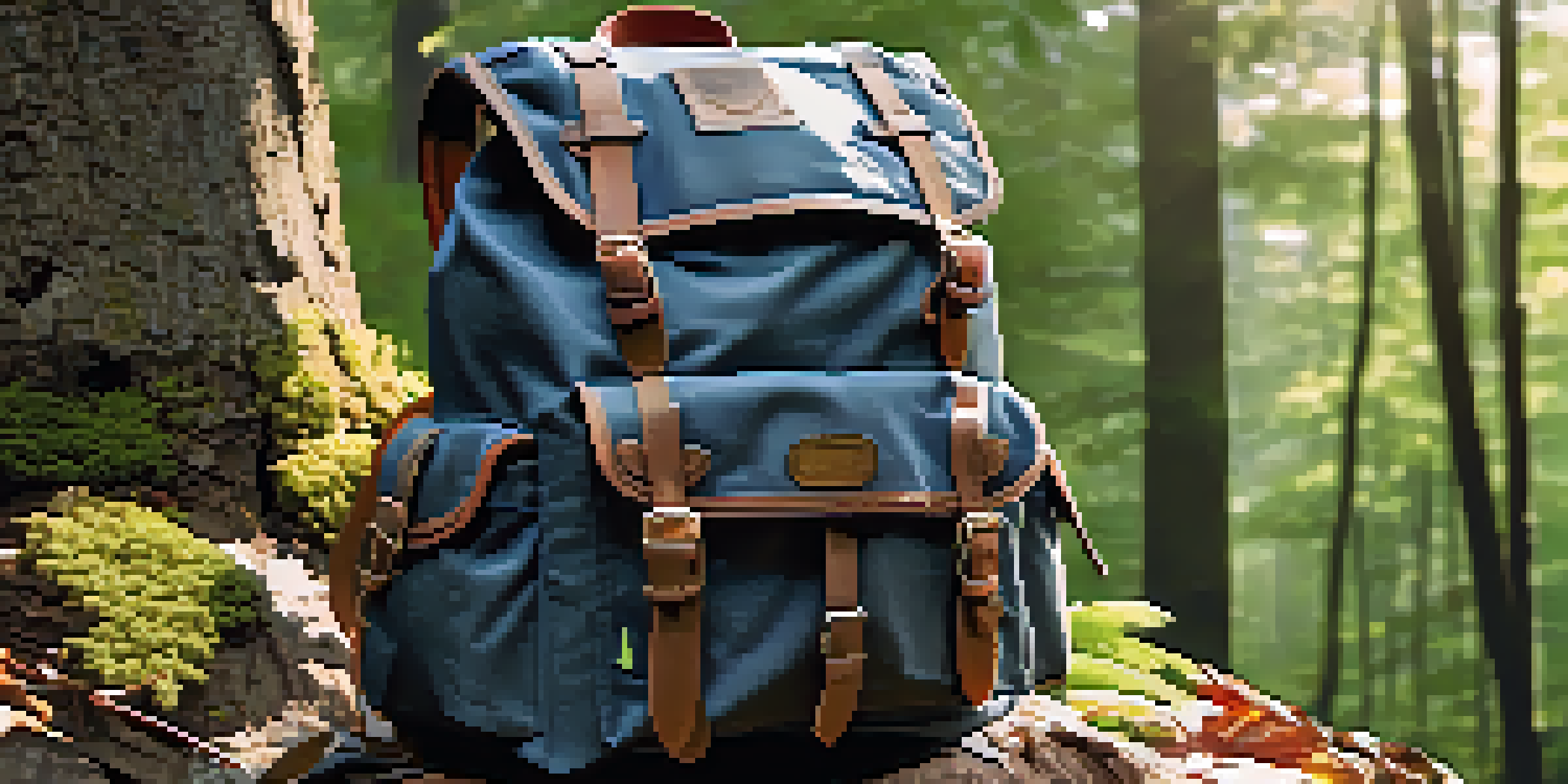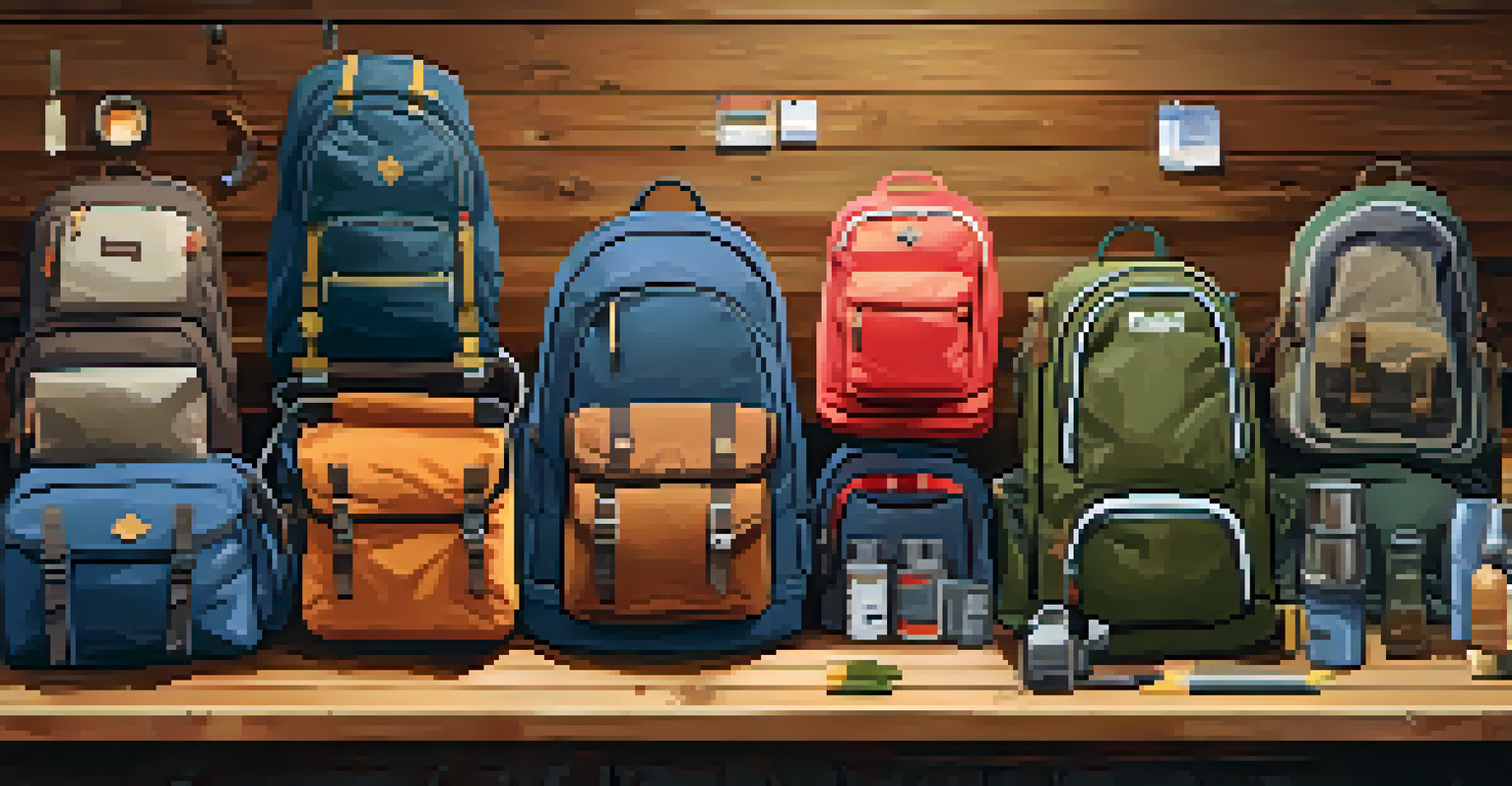Choosing the Right Backpack: A Guide for Campers

Understanding Backpack Types: Which One is Right for You?
When it comes to backpacks, there are several types designed for different activities. For camping, you'll typically encounter daypacks, weekend packs, and multi-day packs. Each type serves a specific purpose, so understanding your needs is crucial before making a decision.
The journey of a thousand miles begins with one step.
For instance, a daypack is perfect for short hikes or day trips, while a weekend pack can accommodate a couple of nights spent in the wild. If you're planning a longer adventure, a multi-day pack will provide the necessary space and comfort for extended trips. Knowing the duration of your camping trip will help you narrow down your options.
In short, consider the length of your adventure, the gear you'll need, and choose a backpack that aligns with those requirements. This foundational knowledge sets the stage for a more enjoyable outdoor experience, allowing you to focus on the beauty of nature.
Backpack Capacity: Finding the Right Size for Your Gear
Backpack capacity is measured in liters, and it’s essential to choose one that fits your gear without being too bulky. As a rule of thumb, a daypack typically ranges from 15 to 30 liters, while weekend packs can range from 30 to 50 liters, and multi-day packs often go above 50 liters. Understanding these sizes ensures you can carry all your essentials without overpacking.

If you're unsure about the size you need, consider laying out all your camping gear and then measuring it to estimate the required capacity. This will give you a clearer picture of what you need while avoiding the temptation to bring everything but the kitchen sink. Remember, a well-packed backpack makes for easier hiking.
Choose the Right Backpack Type
Understanding the different types of backpacks, such as daypacks and multi-day packs, is crucial for selecting one that suits your camping needs.
Ultimately, the right capacity will allow you to enjoy your camping experience without the hassle of a heavy load. Focusing on the essentials will not only lighten your pack but also improve your overall enjoyment of nature.
Weight Distribution: Comfort is Key When Hiking
Comfort is paramount when spending hours on the trail, and proper weight distribution in your backpack plays a significant role. A well-designed backpack will have a frame that helps distribute the weight evenly across your back and hips, reducing strain on your shoulders. This is especially important if you’re carrying a heavier load.
In every walk with nature one receives far more than he seeks.
When packing, place heavier items closer to your back and at the bottom of the pack. This positioning keeps the center of gravity stable, which helps you maintain balance while walking. Additionally, using compression straps can help stabilize the load, preventing items from shifting as you move.
By prioritizing comfort through thoughtful weight distribution, you can ensure a more enjoyable hiking experience. A little attention here can make a big difference in how you feel at the end of the day, leaving you ready for more outdoor adventures.
Adjustable Straps and Fit: The Importance of Personalization
A one-size-fits-all approach rarely works in the world of backpacks. That's why adjustable straps are vital for achieving a personalized fit. Properly adjusted shoulder straps, hip belts, and sternum straps can make all the difference in comfort and support while hiking.
When trying on backpacks, ensure the hip belt sits comfortably on your hips and distributes weight effectively. The shoulder straps should be snug but not constricting, allowing for natural arm movement. Don't forget to adjust the sternum strap to keep the shoulder straps in place and improve stability.
Focus on Comfort and Fit
Proper weight distribution and adjustable straps are essential for a comfortable hiking experience, reducing strain and enhancing support.
Taking the time to find the right fit will not only enhance your comfort but also reduce the risk of injury. When your backpack feels like a natural extension of your body, you can focus more on enjoying your time in nature.
Material Matters: Choosing Durability and Weather Resistance
The material of your backpack can significantly impact its longevity and performance. Look for backpacks made from durable fabrics like nylon or polyester, which are known for their resistance to wear and tear. Additionally, consider options with water-resistant coatings or built-in rain covers to protect your gear from unexpected weather.
For instance, if you often camp in wet conditions, a waterproof backpack could save your gear from serious damage. Similarly, reinforced seams and zippers can enhance durability, making your backpack a reliable companion for years to come. Investing in quality materials pays off in the long run.
Ultimately, choosing the right materials will ensure your backpack stands up to the rigors of outdoor adventures. A well-made backpack not only protects your gear but also enhances your overall camping experience.
Additional Features: What to Look For in a Camping Backpack
When shopping for a camping backpack, consider additional features that can enhance your experience. Look for pockets and compartments that help you organize your gear efficiently. Side pockets for water bottles and zippered compartments for quick-access items can make a significant difference in convenience.
Some backpacks also come with features like hydration reservoirs, which allow you to sip water hands-free while on the trail. Others may include attachment points for trekking poles or gear loops for extra storage options. These thoughtful additions can streamline your camping experience.
Invest in Quality Materials
Selecting durable and weather-resistant materials ensures your backpack lasts longer and protects your gear during outdoor adventures.
In short, the right features can help simplify your camping trips and keep your gear organized. While style is essential, functionality should be at the forefront of your decision-making process.
Budgeting for Quality: Investing in Your Camping Gear
While it may be tempting to go for the cheapest option, investing in a quality backpack can save you money in the long run. A well-constructed backpack not only lasts longer but also performs better, providing you with a more enjoyable hiking experience. Consider your camping frequency and how much use you'll get from the backpack.
Set a budget that aligns with your camping habits, but remain open to spending a little more if it means getting a higher-quality product. Often, brands that specialize in outdoor gear offer warranties, which can provide peace of mind regarding your investment. Researching and reading reviews can also help you make informed decisions.

Ultimately, quality gear enhances your experience and ensures your safety in the great outdoors. By budgeting wisely, you can find a backpack that meets your needs without breaking the bank.